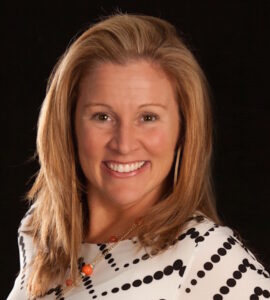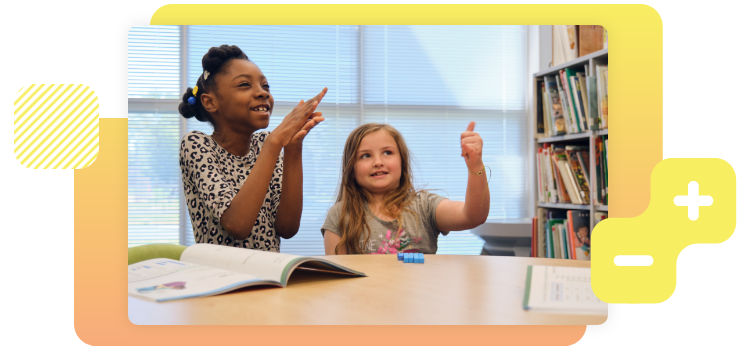Imagine learning to read, and then refining your reading, using only books about particle physics. The US would be overflowing with adults who don’t understand, don’t care and don’t know how to read. For many students, that’s what learning math feels like. A new curriculum called Amplify Desmos Math offers a path to transform every classroom into an engaged math community that invites, values and develops student thinking — bringing students a way to learn — and love — math. Kristin Gray, the executive director of Amplify’s math suite, says Amplify Desmos Math offers “curiosity-driven learning.”

The program is debuting at exactly the right time: Recent math scores on the Nation’s Report Card have raised concerns not just for students’ learning but for their futures. In this Q&A, Gray explains more about the problem and the Amplify solution.
Why is Amplify Desmos Math’s approach to teaching and learning mathematics important for the math education community?
Amplify Desmos Math takes a problem-based learning approach. While problem-based learning isn’t new to math education, there continues to be a lack of curriculum with the necessary guidance and resources for teachers to effectively support each student.
Amplify Desmos Math situates active student learning within meaningful problems with the right level of support for teachers. It embodies the eight effective teaching practices outlined by the National Council of Teachers of Mathematics and fosters a classroom environment where mathematical discourse, problem-solving and reasoning are central. We do this in a handful of ways:
- The program uses innovative structures and design to engage students and effectively support teachers.
- The lessons have a structured flow so teachers can build on and leverage students’ ideas toward a clear synthesis of the mathematics – including built-in time and resources for differentiation.
- The math problems inspire curiosity, increase motivation, encourage collaboration and center students’ ideas. The problems focus on the grade-level math that matters most, attend to all aspects of rigor and build coherently within and across grades.
- Amplify Desmos Math along with its supplemental and assessment companion resources are built within one unified platform. For teachers and students, this makes it easy to navigate and seamless to transition between components while providing a connected experience for the varying needs within the classroom.
How is this structured approach different? What about it makes it easier for teachers to shift to a more collaborative, problem-based learning approach?
A problem-based learning approach is more complex than giving students a problem and hoping they discover the math as they work. In addition to engaging problems, it requires structures to ensure students have access to grade-level math, opportunities to build understanding, synthesis moments to consolidate their learning and practice toward procedural skill and fluency.
This is where I see a lot of curricula fall short — there’s often an overemphasis on one aspect leading to a lack of emphasis on another. For example, many focus heavily on engaging problems but lack the necessary differentiated support and practice. This lack of differentiation support and practice is something we have taken special care to balance in Amplify Desmos Math.
Each lesson in Amplify Desmos Math has a predictable structure of “Launch, Monitor and Connect” to ensure students have access from the outset and teachers have what they need in terms of anticipated responses, questions, and explicit moments to connect and synthesize students’ ideas.
The curriculum also includes a “Support, Strengthen and Stretch” structure that helps teachers differentiate in ways that keep students working on, and toward, grade-level mathematics through additional lesson and fluency practice, extensions and teacher-led mini-lessons.
Tell us a little about the success you’ve seen in trials, like with Seaford School District in Delaware.
I am so fortunate to partner with the Seaford School District teachers to field-trial and pilot our materials. I am able to see first-hand how the materials play out in a classroom! It’s invaluable to get teacher and student feedback on the Amplify Desmos Math materials in such early stages to make adjustments that better support teaching and learning.
The teachers are excited about Amplify Desmos Math’s focus on teacher support, particularly additional practice and differentiation resources. They have been struggling to find their own resources — previously having to purchase unaligned supplemental programs and find worksheets from random math sites.
The students absolutely love our digital lessons because of the contexts, dynamic interactions and feedback that honors their thinking. Teachers find the facilitation tools helpful and say the joy students find in these lessons is undeniable and a much needed break from the print workbook monotony.
In this video, students and teachers talk about using Amplify Desmos Math curriculum. (Amplify/YouTube)
The K–5 teachers are currently piloting our mini-lessons for teacher-led small groups. They appreciate the mini-lesson structure of: worked example, guided practice with faded scaffolds, and a “check” problem to formatively assess student understanding.
How does consistency figure into Amplify Desmos Math?
The program has consistency in the coherence of the mathematics and curriculum design. The coherence of the math includes alignment to grade-level standards that ensure a mathematical story across lessons, units and grade levels. This coherence supports all students in accessing grade-level math and seeing math as a connected set of ideas.
The consistent lesson and differentiation structures make for a predictable lesson flow and easier decision-making for the teacher. Each lesson follows a “Launch, Monitor, Connect” structure making lessons easy to navigate and allowing a teacher’s focus to be on the students and the math. Our “Support, Strengthen and Stretch” differentiation structure provides teachers with recommendations and resources for just-in-time support.
While consistency and structure are extremely important, we also made sure the materials provided teachers with options to flexibly use the resources in ways that work for them and best meet the needs of their students.
One of your themes is “Math that motivates.” How will the program motivate students?
Research shows that student motivation is not solely an individual trait but rather emerges through dynamic interactions between the learner and their environment. Amplify Desmos Math attends to these dynamic interactions in every lesson.
Each unit and lesson begin with an invitation to the mathematics, connecting to and building on what students know. The activities include meaningful and engaging problems around which students work individually and collaboratively, sharing their rough draft ideas along the way. Teachers then leverage the ideas that emerge from these interactions to move learning forward.
And, what could be more motivating than having access to the content, representing it in ways that make sense to you, collaborating with your classmates and having opportunities to revise and refine your thinking as you learn?
What will teachers like most about Amplify Desmos Math?
Based on my years of experience with problem-based learning and work with teachers implementing this instructional approach, I think teachers will absolutely love that Amplify Desmos Math makes teaching math feel more doable. I have yet to encounter a problem-based program with this level of structured support.
All of this support, alongside engaging problems, increased collaboration, explicit synthesis moments and differentiation resources, is a dream. When I was in the classroom, anything that reduced the number of logistical decisions I needed to make and lessened the amount of time it took to find differentiation resources would have been amazing!
One of my favorite researchers around teacher’s curriculum use, Janine Remillard, described curriculum use as a dynamic and ongoing relationship between teachers and resources—a relationship shaped by both the teacher and characteristics of the resource. My hope is that each teacher forms an ongoing relationship with Amplify Desmos Math that creates truly meaningful mathematical experiences for themselves and students.
Opinions expressed by SmartBrief contributors are their own.
_________________________
Subscribe to any — or several — of SmartBrief’s more than 250 industry-focused free newsletters.
